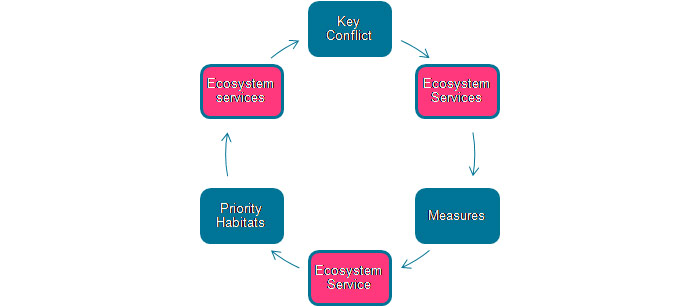

Disclaimer:
The authors are solely responsible for the content of this report. Material included herein does not represent the opinion of the European Community, and the European Community is not responsible for any use that might be made of it.
Back to overview reports
It is in such a role that it is considered that the conflict matrix approach is of value, particularly when used in conjunction with the measures tools developed under TIDE and with the Ecosystem Services approach, this combined approach allowing the Ecosystem Services to provide a common currency to assist in the determination of the relative values of management options, and appropriate management measure delivery (Figure 28).
It is concluded that whilst north-west European estuaries present many generic management challenges, initiatives need to be site-specific in order to accommodate both the natural and human systems. Furthermore, the Ecosystem Services and Conflict Matrix approaches employed in TIDE have the potential to be combined to assist in effective management. However, importantly it is necessary to understand that measures employed to provide a management solution for specific problem can also generate their own management issues. This is particularly the case for measures used to address flood protection, land claim offset and Natura 2000 requirements.
Back to top
How can multiple estuarine resource use be managed in an integrated way within the existing planning system?
How can the Ecosystem Services Approach be used to support management decisions?
How do TIDE estuaries deal with management problems?
How does the societal demand for ecosystem services vary along the estuary gradient?
What are the key areas of conflicts or synergies in TIDE estuaries?
What tool is available to help manage multiple users of a resource in an integrated way (i.e. achieving more holistic management)?
What tools are useful for involving local communities and stakeholders?
Which aspects do I have to take into account in order to make a measure a success?
Which synergistic effects and conflicts can be expected by planning and implementing a certain measure?
Analysis of the TIDE Estuarine Conflict Matrices
Table of content
- 1. SUMMARY
- 2. INTRODUCTION
- 2a. General
- 2b. Research Aims
- 2c. Conflict Matrices
- 2d. Conflict Matrix Tool
- 3. CONFLICT MATRIX METHODOLOGY
- 3a. Approach
- 3b. Analysis
- 4. CONFLICT MATRIX SET-UP PROCESS FINDINGS
- 4a. Salinity/Management Zone Extent Comparison
- 4b. Regional Working Group (RWG) Composition and Interests Comparison
- 4c. Conflict Matrix Estuary Zone Level of Use Comparison
- 4d. Generic Estuary Conflict Scores
- 5. CONFLICT MATRIX OUTCOMES ANALYSIS PER ESTUARY & ZONE
- 5a. Elbe Estuary Conflicts Analysis
- 5b. Weser Estuary Conflicts Analysis
- 5c. Scheldt Estuary Conflicts Analysis
- 5d. Humber Estuary Conflicts Analysis
- 5e. Estuary Conflict Matrix Analysis Summary
- 6. TYPOLOGY OF ASSOCIATIONS ACROSS ALL TIDE ESTUARIES
- 6a. Management Awareness and Focus
- 6b. Salinity Zone Associations
- 6c. Conflict Interaction Typology
- 7. DISCUSSION & RECOMMENDATIONS
- 7a. Spatial Conflict Variation
- 7b. Sectoral Conflict Variation
- 7c. Conflict Management
- 7d. Measures Interactions and Disbenefits
- 7e. Links to Other Approaches
- 8. REFERENCES
- 9. APPENDICES
7e. Links to Other Approaches
Based on the results of the conflict matrix approach, together with research strands from other aspects of TIDE, it has been possible to derive a typology of key conflict areas for most estuaries, and based on these, derive guidance principles for integrated management as well as a series of measures to assist in both in determining conflict areas, but also in addressing some of the causal impact factors.It is in such a role that it is considered that the conflict matrix approach is of value, particularly when used in conjunction with the measures tools developed under TIDE and with the Ecosystem Services approach, this combined approach allowing the Ecosystem Services to provide a common currency to assist in the determination of the relative values of management options, and appropriate management measure delivery (Figure 28).
It is concluded that whilst north-west European estuaries present many generic management challenges, initiatives need to be site-specific in order to accommodate both the natural and human systems. Furthermore, the Ecosystem Services and Conflict Matrix approaches employed in TIDE have the potential to be combined to assist in effective management. However, importantly it is necessary to understand that measures employed to provide a management solution for specific problem can also generate their own management issues. This is particularly the case for measures used to address flood protection, land claim offset and Natura 2000 requirements.
Important to know
Reports / Measures / Tools
| Report: | Zonation of the TIDE estuaries (Functioning) |
|---|---|
| Report: | Ecosystem Service Assessment of TIDE Estuaries (Functioning) |
| Report: | Legislative Drivers & Sectoral Plan Review of TIDE Estuaries (Governance) |
Management issues
How can management actions be prioritised based on conflict assessment outcomes?How can multiple estuarine resource use be managed in an integrated way within the existing planning system?
How can the Ecosystem Services Approach be used to support management decisions?
How do TIDE estuaries deal with management problems?
How does the societal demand for ecosystem services vary along the estuary gradient?
What are the key areas of conflicts or synergies in TIDE estuaries?
What tool is available to help manage multiple users of a resource in an integrated way (i.e. achieving more holistic management)?
What tools are useful for involving local communities and stakeholders?
Which aspects do I have to take into account in order to make a measure a success?
Which synergistic effects and conflicts can be expected by planning and implementing a certain measure?
